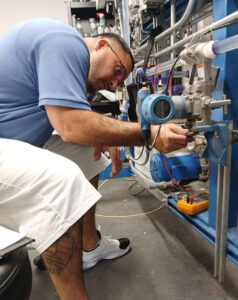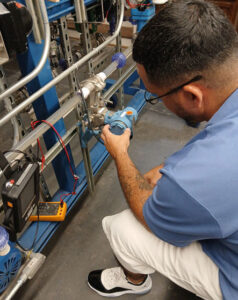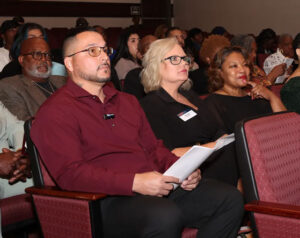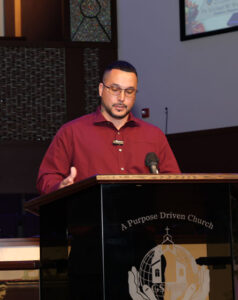Building a Second Chance Through Construction Education
 Anthony Hernandez stood behind the podium and looked out at the crowd in front of him. He was the keynote speaker at the graduation ceremony for the Community Construction Academy (CCA), a rigorous 16-week hands-on program that helped teach construction skills to underserved community members in Birmingham, Alabama.
Anthony Hernandez stood behind the podium and looked out at the crowd in front of him. He was the keynote speaker at the graduation ceremony for the Community Construction Academy (CCA), a rigorous 16-week hands-on program that helped teach construction skills to underserved community members in Birmingham, Alabama.
This was unfamiliar territory — he wasn’t a public speaker. He was building a career as an instrumentation technician after earning his credentials from the National Center for Construction Education and Research (NCCER).
But his knowledge of using flowmeters and pressure gauges or how to test and repair electrical instruments isn’t why the organizer of the event, Mittie Cannon, asked him to speak in front of the graduates that day: It was his story.
Like many of the people in the audience, Hernandez’s story had a difficult beginning. As a young man, he had gone from delinquency to prison and spent 11 years behind bars. However, just as the graduates of the academy had recently discovered, education could provide a path forward.
He ultimately found success because, as he said, “Somebody gave me a second chance.”
Life on the Streets
Hernandez grew up in West Palm Beach, Florida, and lived a difficult childhood. His background, like that of many distressed youths, was one of the streets. He had grown up around a lot of crime and violence, including seeing family members using and selling drugs.
Hernandez dropped out of school in the ninth grade. He was put in a position where he took care of his siblings, and also his father much of the time.
“I had a very troubled and disturbing childhood, which led me to make grown man decisions at a very young age. I was forced into a lifestyle,” he said, before adding: “Not necessarily forced, because we all have a choice.”
The pressure and stress from that life led to bad choices that eventually landed Hernandez in a juvenile program at the age of 15. He was released at 17 in a deep hole that would take years to dig out of.
Life on the Inside
By the age of 24, Hernandez was on his second stint in federal prison serving a mandatory minimum of 20 years.
One day, an offhand conversation with another older, long-time prisoner changed Hernandez’s life.
“What makes you think you’re gonna get outta here…and stay out?” the older prisoner had pressed him. “You sold drugs to get in here. You’re selling drugs now. What makes you think you won’t be selling them again once you get out? You got your GED? No! Have you got any vocational trade? No! Where have you worked besides McDonald’s?”
Hernandez recalled his former peer’s conclusive call to action: “Go get your GED, man!”
The comment lingered in Hernandez’s mind and kept him up through the night.
“It just kept echoing in my head,” said Hernandez.
The Path of Education
After a sleepless night, Hernandez found a new energy and focus. The conversation had provoked him and made him look deep inside himself. He now understood that the path out of prison—and the very lifestyle that had brought him there—was through education.
That morning, Hernandez was the first person in the front row of the facility’s GED class.
Within six months, he had earned his certificate. The accomplishment was the first time in his life he could remember completing something on his own and it wasn’t negative.
“When I got my GED, it felt amazing!” Hernandez smiled with pride.
 With a new sense of self-worth and confidence, he continued to further his education. He took training courses for various vocational trades, including electrical, HVAC, custodial maintenance, landscape management and more.
With a new sense of self-worth and confidence, he continued to further his education. He took training courses for various vocational trades, including electrical, HVAC, custodial maintenance, landscape management and more.
In addition to learning new useful skills, Hernandez saw another potential benefit: The judicial system tended to look positively on people who tried to better themselves while incarcerated. Although his mandatory minimum sentence presented further obstacles, Hernandez wanted to be ready in case future legislation created an opportunity.
“I knew if a law would ever pass, educating myself was my ticket out,” he said.
Preparation Pays Off
In 2018—11 years into Hernandez’s 20-year sentence—Congress passed the First Step Act. This had been the break that Hernandez was hoping for. The law created a system in which some incarcerated individuals can earn time credits for participating in productive activities like craft training so they’re equipped to succeed when released.
The First Step Act, along with a prior law, the Fair Sentencing Act of 2010, set the stage for Hernandez’s release. Because of the two laws, his sentence was reduced from 20 years down to 10 years. Having already served the full term of the revised sentence, Hernandez was granted immediate release from the Federal Correctional Institute in Miami, Florida in March of 2019.
Life on the Outside
To build a new life for himself, he needed a job. But finding one proved to be difficult. HVAC and electrical companies he applied to didn’t recognize the credentials he received while incarcerated. With his trades training not being acknowledged, plus the stigma attached to him as a former prisoner, it seemed impossible to get hired.
“It was disappointing and I felt defeated,” he said. “But I knew selling drugs and going back to prison wasn’t an option.”
Through a chance encounter, Hernandez crossed paths with an old friend who was an instrumentation technician. The friend offered him some work assisting him on a temp job.
“I couldn’t even say instrumentation tech back then. I was like, ‘Instrument what?’”
Hernandez liked the work and the pay was good. After the job was complete, his friend told him if he wanted more opportunities, he’d need to go to school and get the credentials that companies would be looking for.
NCCER and Dr. Mittie Cannon

As his friend had suggested, Hernandez made calls to several local colleges and was eventually referred to NCCER, where he spoke with Senior Workforce Development Manager, Nicole Kitler. She advised him to reach out to Mittie Cannon. Kitler said if anyone could guide him, it would be her.
With more than two decades of experience in construction recruiting, education and mentorship, Cannon proved to be the guide that Hernandez was looking for.
“One thing I learned quickly about Cannon is she is very tough, she has high standards, she doesn’t cut corners,” Hernandez said.
Cannon made it clear that Hernandez would need to pay his dues, but if he put in the effort, had the right attitude and desire, opportunities in construction existed for him.
With the same determination that led him to earn his GED certificate in prison years before, Hernandez completed an NCCER training program, earning him the credentials and skills he would need to find a sustainable career as an instrumentation technician.
It was a long road, but Anthony Hernandez now had what he needed to write the next chapter in his story.
And when Cannon was looking for a speaker for the graduation ceremony of one of her other programs, she knew whose story had to be told.
A Second Chance
 Now standing before the graduates of the Birmingham CCA cohort, the ex-prisoner-turned-keynote-speaker reflected on his second chance, and the work that went into making it count.
Now standing before the graduates of the Birmingham CCA cohort, the ex-prisoner-turned-keynote-speaker reflected on his second chance, and the work that went into making it count.
“To be ready for a second chance, do things differently than before. Change your surroundings and perspectives on people, places and things,” he said.
In acknowledging the impact of the education and the personnel that made his new career possible, Hernandez also reminded the crowd that an opportunity is only as good as what you put into it.
“Second chances are not just about someone opening a door for you. It’s about doing what it takes to be ready to enter that door.”

